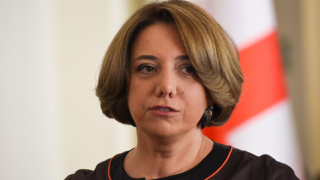Salome Samadashvili: “In 2014, the share of Georgia’s export to the EU was 27% and it has currently dropped to 15%.”
Verdict: FactCheck concludes that Salome Samadashvili’s statement is HALF TRUE.
Resume: In 2014, the share of Georgia’s export to the EU was 22% and it decreased to 15% in 2022. However, the value of export increased by 38% from USD 624 million to USD 863 million in the same period.
In the first eight months of this year, the EU’s share in Georgia’s total exports shrank to 12%, although in this case export value also decreased as compared to the same period of the previous year. In the first eight months of 2022, Georgia exported USD 568 million worth of products to the EU. This amount was USD 506 million in the first eight months of 2023.
If we do not consider the ongoing year which is not yet over, the value of export to the EU was increasing in the previous periods, albeit at a slower rate as compared to other countries.
The Russian market has been open since 2013 and a free trade agreement with China went into effect in 2018. Neither Russia nor China have such strict requirements to grant access to their markets as compared to the EU which lead to the rising interest in those markets.
After Russia’s invasion of Ukraine, Georgia’s export to CIS countries increased which resulted in a decrease of the EU’s share in Georgia’s exports. However, of mention is that export largely surged at the expense of re-export because of the increase in reselling US-made and EU-made cars.
Analysis
On 4 October 2023, Salome Samadashvili, MP, noted in her question to the Minister of Economy and Sustainable Development, Levan Davitashvili, that the EU’s share in Georgia’s foreign trade has decreased of late. In particular, Ms Samadashvili stated: (from 1:29): “In 2014, the share of our export to the EU was 27% and it has currently dropped to 15%.”
Georgia signed the Association Agreement with the EU on 27 June 2014 and as a result, Georgian products are no longer subject to customs tax in the EU market.
Granting free accesses to the USD 16 trillion-strong economy with an over 500-million population (including the EU) was seemingly supposed to result in a sharp growth of export, although this did not happen. Export’s value increased, albeit at a slow rate.
Graph 1: Export to the EU

Source: National Statistics Office of Georgia
As of 2004, the EU included 25 member states, Bulgaria and Romania joined in 2007, Croatia in 2013 and the UK was removed from the list in 2021. In 2021, a total of USD 24 million worth of products were exported to the UK, followed by USD 15 million in 2022 and USD 7 million in the first eight months of 2023 which is why Brexit has not significantly affected Georgia’s exports to the European Union.
As can be seen from the graph, exports to the EU have growth dynamics in terms of value but they do not change much in percentage terms in the long term.
In 2013, exports to Russia increased fourfold from USD 47 million to USD 191 million and the growth continued in subsequent years, except for 2015. In 2015, due to various reasons (the economic decline in Russia, Azerbaijan’s decision to restrict the import of cars manufactured before 2006, Armenia's accession to the Eurasian Union), the drop in exports to Russia and other CIS member states led to a sharp increase in the share of exports to the EU whilst the increase in monetary value was insignificant.
In 2022, exports to the EU increased by 7%, to the CIS by 31% and to China by 255% as compared to 2019 due to which the share of the EU in exports decreased from 22% to 15%.
In January-August 2023, exports to the EU decreased by 9% as compared to the same period of the previous year, including the export of copper ores by 18% from USD 288 million to USD 235 million. The total export of the same products including what was also sent to other countries decreased by 40% from USD 684 million to USD 407 million.
Although total exports increased by 14% in the first eight months of this year, local exports decreased by 22%. The increase in total exports occurred at the expense of re-exports which doubled in January-August as compared to the corresponding period of the previous year.
After the Russian invasion of Ukraine, re-exports increased mainly at the expense of cars. In January-August 2023, car exports increased by 370% as compared to the same period of 2021. This does not mean that Georgia violates the sanctions. In July, cars worth USD 13 million were exported from Georgia to Russia and the value amounted to only USD 780,000 in August. The sharp decline was preceded by the decision of the United States which banned the export of US-made cars to Russia. In addition to Russia, the export of cars both in 2022 and 2023 has increased in Armenia, Azerbaijan and, especially, in Central Asian countries where cars were bought from Russia before the war.
Salome Samadashvili’s statement (the EU's share in exports decreased from 27% to 15%) led to an impression that exports to the EU almost halved from 2014 which is not true.
The share of exports to the EU has indeed decreased and this has two major explanations: on the one hand, this is the increase in exports to other countries, especially re-exports in 2022-2023 and, on the other hand, it is the recent global decrease in demand for copper ores.
Thus far, there has not been an officially confirmed fact of exporting sanctioned goods to Russia or Belarus. Sanctions do not apply against other countries where exports have increased and the fact that car exports have increased in Kazakhstan or Kyrgyzstan cannot be considered as a change in the foreign policy vector.
Georgia cannot have an impact on the global demand for copper ores. The fact that over the years Georgia has not been able to increase production or improve quality is a separate problem and a topic for another discussion.
Given the more or less accurate numbers but the erroneous interpretation of these numbers, FactCheck concludes that Salome Samadashvili's statement is HALF TRUE.







